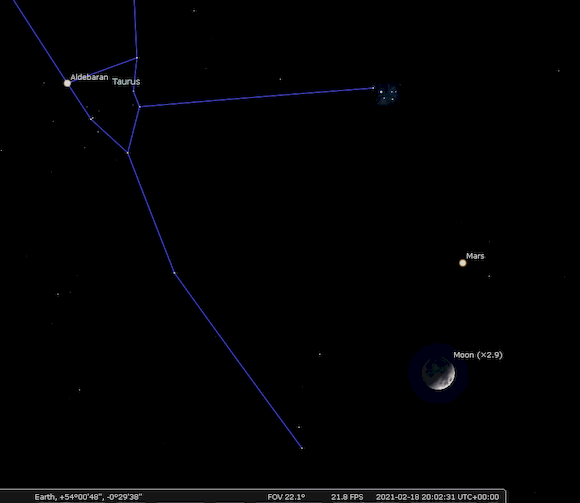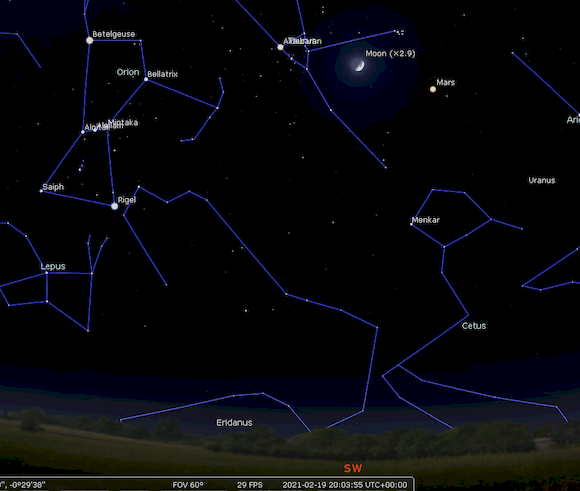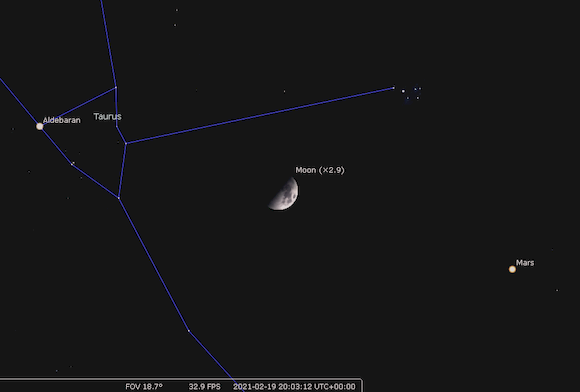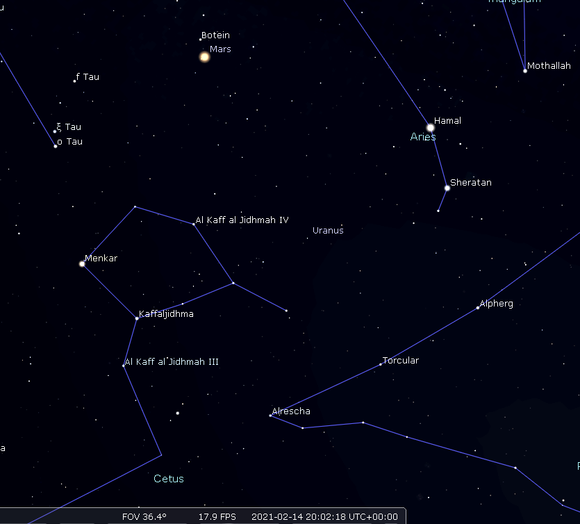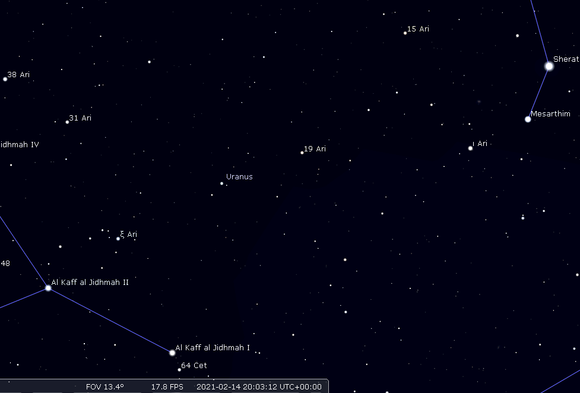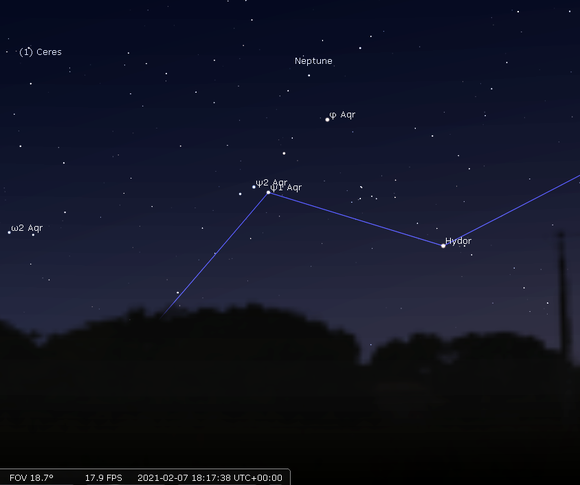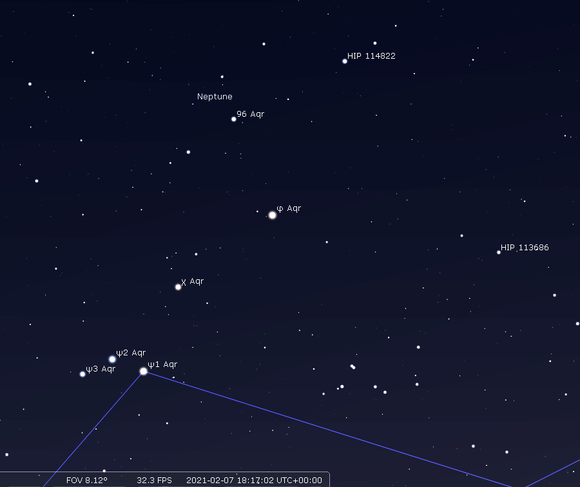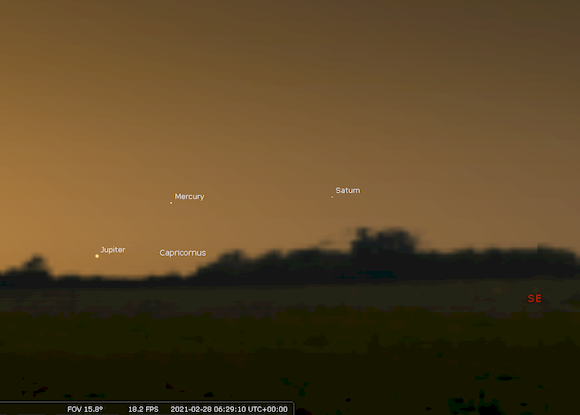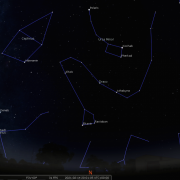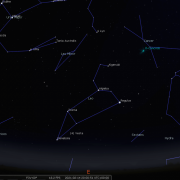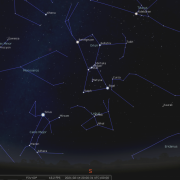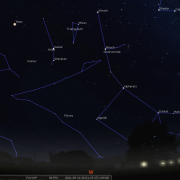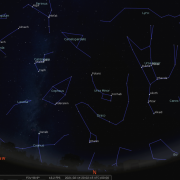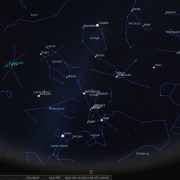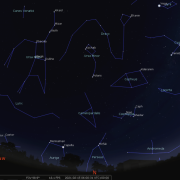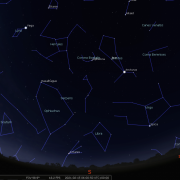In this month's Sky Notes:
Planetary Skylights - Brief
Mars is the sole naked eye planet visible in the evening sky following the departure of Mercury after the first few days of February. Later on in February Mercury emerges into the dawn sky and is joined by Jupiter and Saturn, so that once again this trio of planets are together!
 After a decent apparition in January, Mercury may be glimpsed just above the WSW horizon for the first few days of February, as long as you have a flat horizon aspect in this direction. You will need to observe 5 minutes either side of 16:30hrs to stand the best chance of spotting the innermost planet which will be shining at mag +1.4. You should pick it up easily in binoculars. By the 4th Mercury will be lost again, but will return to the dawn sky later in the month (see morning planets)
After a decent apparition in January, Mercury may be glimpsed just above the WSW horizon for the first few days of February, as long as you have a flat horizon aspect in this direction. You will need to observe 5 minutes either side of 16:30hrs to stand the best chance of spotting the innermost planet which will be shining at mag +1.4. You should pick it up easily in binoculars. By the 4th Mercury will be lost again, but will return to the dawn sky later in the month (see morning planets)
 Mars becomes the sole survivor of autumn's planetary gang visible to naked eye. After 'buzzing Uranus last month, Mars spends February inching up through the constellation of Aries toward the two famous star clusters in Taurus; the Pleiades and the Hyades. Mars actually passes below the Pleiades in early March. At the start of February Mars appears around mag +0.46, which diminishes to +0.9 by the end of the month, still reasonably bright to the naked eye. The red planet will be riding high as twilight falls, approximately 50 degrees up, well clear of the worst of the seeing at lower altitudes. The downside is that Mars is now not much of a spectacle through the eyepiece, a small, orange, rather featureless and slightly gibbous ball less than 8 arc seconds in diameter, almost 3 times smaller than when at opposition last October. On the 18th and 19th a waxing crescent moon passes Mars, adding to the already scenic view. By the 24th Mars moves into Taurus, and by the end of the month is on view for a window of 4 hours only, before setting around 22:45hrs.
Mars becomes the sole survivor of autumn's planetary gang visible to naked eye. After 'buzzing Uranus last month, Mars spends February inching up through the constellation of Aries toward the two famous star clusters in Taurus; the Pleiades and the Hyades. Mars actually passes below the Pleiades in early March. At the start of February Mars appears around mag +0.46, which diminishes to +0.9 by the end of the month, still reasonably bright to the naked eye. The red planet will be riding high as twilight falls, approximately 50 degrees up, well clear of the worst of the seeing at lower altitudes. The downside is that Mars is now not much of a spectacle through the eyepiece, a small, orange, rather featureless and slightly gibbous ball less than 8 arc seconds in diameter, almost 3 times smaller than when at opposition last October. On the 18th and 19th a waxing crescent moon passes Mars, adding to the already scenic view. By the 24th Mars moves into Taurus, and by the end of the month is on view for a window of 4 hours only, before setting around 22:45hrs.
The Moon visits Mars on the 18th and 19th, whilst the Hyades and Pleiades watch on!
(click for larger image)
 Uranus continues to be well placed for observation in the evening sky, residing just within the borders of Aries, below and left of the ‘crooked line’ asterism of the Ram marked by the stars Hamal, Sheratan and Mesatim and aorund 1.5 degrees SE of 19 Ari. Having been visited by Mars last month, Uranus is once again 'in isolation'. At mag +5.8 Uranus is borderline naked eye for keen sighted observers viewing from dark viewing locations (assuming they know exactly where to look). Through binoculars Uranus resembles a rather faint star, off white in hue. You will require a telescope (80mm upwards) to discern its tiny disk, which appears slightly ghoulish green in luster.
Uranus continues to be well placed for observation in the evening sky, residing just within the borders of Aries, below and left of the ‘crooked line’ asterism of the Ram marked by the stars Hamal, Sheratan and Mesatim and aorund 1.5 degrees SE of 19 Ari. Having been visited by Mars last month, Uranus is once again 'in isolation'. At mag +5.8 Uranus is borderline naked eye for keen sighted observers viewing from dark viewing locations (assuming they know exactly where to look). Through binoculars Uranus resembles a rather faint star, off white in hue. You will require a telescope (80mm upwards) to discern its tiny disk, which appears slightly ghoulish green in luster.
 Residing in the constellation of Aquarius which is now slipping down to the SW horizon, early February will be the final opportunity to spot Neptune for a few months as it will be lost to solar glare by the 10th. Realistically, there will be little more than 30 mins in which to track it down, so view from 18:00-18:30hrs hrs. It can be located just over a degree north-east of the star Phi aqr (mag +4.2) and just under half a degree ESE of 96 aqr. (mag+5.5). You will certainly require a telescope to spot the diminutive disk, which is just 2 arc degrees in size and has a blue/grey hue.
Residing in the constellation of Aquarius which is now slipping down to the SW horizon, early February will be the final opportunity to spot Neptune for a few months as it will be lost to solar glare by the 10th. Realistically, there will be little more than 30 mins in which to track it down, so view from 18:00-18:30hrs hrs. It can be located just over a degree north-east of the star Phi aqr (mag +4.2) and just under half a degree ESE of 96 aqr. (mag+5.5). You will certainly require a telescope to spot the diminutive disk, which is just 2 arc degrees in size and has a blue/grey hue. Dawn Planets
 The elusive messenger of the god's; Mercury, wastes little time 'hot footing' it from the evening sky to the dawn sky. Having been visible at the start of February in the evening twilight, it returns to the dawn sky shortly after mid month, being visible very low in the ESE. Again, you will require a flat horizon to spot Mercury (and the other planets here) from the 18th onwards. Mercury will grow in brightness over the duration of the apparition and by the end of February will be +0.23 in magnitude, visible to the naked eye if you observe from 06:30h to 06:45h, scanning around 5 degrees above the ESE horizon. At that time Saturn will lie off to the right at a similar altitude, but will be somewhat fainter than Mercury, whilst Jupiter will be apparent lower left of Mercury, just above the horizon, appearing by far the brightest of the trio.
The elusive messenger of the god's; Mercury, wastes little time 'hot footing' it from the evening sky to the dawn sky. Having been visible at the start of February in the evening twilight, it returns to the dawn sky shortly after mid month, being visible very low in the ESE. Again, you will require a flat horizon to spot Mercury (and the other planets here) from the 18th onwards. Mercury will grow in brightness over the duration of the apparition and by the end of February will be +0.23 in magnitude, visible to the naked eye if you observe from 06:30h to 06:45h, scanning around 5 degrees above the ESE horizon. At that time Saturn will lie off to the right at a similar altitude, but will be somewhat fainter than Mercury, whilst Jupiter will be apparent lower left of Mercury, just above the horizon, appearing by far the brightest of the trio.
 Saturn returns to the dawn sky shortly after Mercury does, visible towards the end of February low in the ESE around 06:30hrs. You will require an unobstructed aspect to view it. At mag +1.4 Saturn will be a little challenging to spot with the naked eye initially. Binoculars will help pick it out, but a telescope will be required to make out the rings, although at this stage viewing will be poor, and with limited time availability, probably can wait several weeks.
Saturn returns to the dawn sky shortly after Mercury does, visible towards the end of February low in the ESE around 06:30hrs. You will require an unobstructed aspect to view it. At mag +1.4 Saturn will be a little challenging to spot with the naked eye initially. Binoculars will help pick it out, but a telescope will be required to make out the rings, although at this stage viewing will be poor, and with limited time availability, probably can wait several weeks.
 Jupiter creeps back into the dawn sky by late February and will be the brightest of the trio of planets visible low in the ESE, being also the lowest in altitude. Probably not viable as regards observation through the eyepiece of a telescope, it will however be rewarding to track all three planets down with binoculars, before trying with just the naked eye.
Jupiter creeps back into the dawn sky by late February and will be the brightest of the trio of planets visible low in the ESE, being also the lowest in altitude. Probably not viable as regards observation through the eyepiece of a telescope, it will however be rewarding to track all three planets down with binoculars, before trying with just the naked eye.
Meteors- The 'fireball' season

There are no recognised meteor showers of note during February, but you may still spot the odd sporadic meteor. The Alpha Aurigids are a very minor shower running from mid January thru' to mid February, however numbers are indistinguishable from sporadic levels; barely 2-5 per hour. That said, meteors witnessed at this time of year are quite often bright, indeed it has been suggested that late January to March; the 'fireball' season', may be a very old depleted shower of similar nature to the Geminids, composed of more dense, rocky debris. If you do spot a meteor speeding away from near Capella (alpha aurigid) make a mental note, otherwise it's just a sporadic with no name, but you could call it Bob if you want to!
February 2021 Sky Charts
Additional Image Credits:
- Planets and Comets where not otherwise mentioned: NASA
- Sky Charts: Stellarium Software and Starry Night Pro Plus 8
- Log in to post comments


